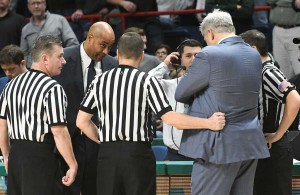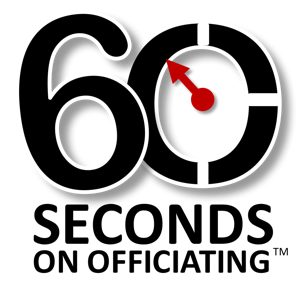
Don’t Get Struck By The AP Arrow
The rhythmic back and forth cadence of the alternating possession (AP) arrow appears to have come to a screeching halt in your game as both head coaches are making strenuous arguments to one of your partners as to why this latest held ball should be awarded to their team.
You join the discussion and quickly begin to process the information flowing to you at a passionate decibel level.
You learn that on the previous AP throw in, Team A’s entry pass was kicked by Team B. The official ruled a violation on Team B and administered another spot throw in for Team A.
The throw in was successfully completed, the AP arrow was turned in the direction of Team B’s basket, and played proceeded uninterrupted until this moment in the closing minutes of a very close game.
Is Team A or Team B entitled to take possession in this scenario?
The officials correctly determined that Team A should have retained the AP arrow because Team B’s violation for kicking the ball on the entry pass negated the opportunity to complete the AP throw in.
Now the opportunity to complete the AP throw does occur if the throw in team commits a violation, in this case, Team A. Subsequently, Team B would take possession, and would have the AP arrow on the next held ball situation. In addition to a defensive team violation keeping the arrow pointed in the same direction, so would a foul (personal or technical) committed by either team keep the AP arrow from being switched.
Remember there are two scenarios when the AP arrows is not changed:
- A DEFENSIVE violation occurs.
- EITHER team (or BOTH teams) commit a foul.
The team obtaining control of the jump ball to start the game or any overtime session establishes the A-P procedure, and the arrow is set towards the opponents basket. If there is a loose ball scramble for possession off the opening or overtime tip off and the officials are unable to determine who caused the ball to go out of bounds, the center circle jump will be repeated with the two closest players.
Control can also be established by the results of a foul or violation. If Team A commits a foul or a violation during the jump ball; Team B would inbound the ball at the closest spot to the infraction, and the AP arrow would be pointed toward Team A’s basket.
The 60 Seconds on Officiating mantra of, “rule competency breeds calmness and confidence in chaos” would certainly have nipped this problem in the bud by the officials being pro-active and making it known to the good person working the AP arrow at the score table to not change the arrow in the scenario detailed above.
Remember, the normally conscientious people staffing the table are an extension of the officiating crew, and it is your job to work together to make sure they carry out their respective assignments flawlessly.
This will go a long way to keeping everyone from being struck and wounded by a misplaced arrow.
NFHS Rule Reference:
4-3 and 6-4

Why in the picture is the official grabbing the coat of the coach
He likes him.
Two add ons to a good article… be proactive with table regarding AP arrow following a time out; a warning for an end line infraction has no impact on the AP arrow
Also: when a throw-in is illegally contacted by the defense (e.g., kicked), the clock should not start (5-9-4). So it’s always a good idea to glance at the clock before making the ball available to the thrower so you are able to accurately instruct the timer to restore the clock to where it was. This may be a critical correction with just seconds remaining in a close game.
Here’s one. Midway through first half there’s a held ball. Arrow points to team A, but after the whistle a team A player gets a technical foul. Team B will shoot the technical, but who gets the ball and the arrow? My guess is B gets the ball opposite the table, but I’m not sure on arrow. Since A never actually got the ball does it stay with them or does it change because the T occurred after the held ball?
Heres a question for you.
The thrower during an AP throwi-n reaches the ball across the plain, which is then lefally grabbed by the defender for a held ball.
What now?
pardon my fat fingers on my phone. “throw-in” “legally”
I see this has been answered in another thread.
Ruling: The official should rule a HELD BALL ball and give the ball back to team A for a new alternating possession throw-in, since the arrow is still pointing toward team A.
NFHS Reference: 6-4-4, 4-42-5a
The throw in ended as soon as the ball was legally touched by team B. The touch instantaneously preceded the held ball. How do you get a held ball when one of the players is out of bounds?
I have an out of bounds violation and the arrow for B after B completes the out of bounds violation throw in.
Am I wrong?
Officials on the floor now have an opportunity to personally track AP with Discbands alternating possession wristband to help prevent discrepancies. Signal it, see the team indicator represented by the interchangeable discs, make the right call quickly and professionally. Upon legal throw in, simply rotate the disc on the wristband axle in less than 1 second and you’re ready for the next call. Easy and professional. Ideal for any game where you want to be right about the AP.